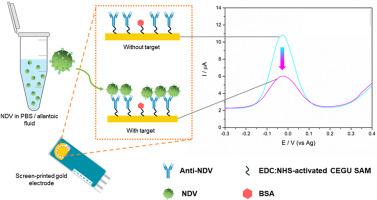含聚乙二醇的自组装单层修饰金电极上基于伏安法的新城疫病毒免疫传感。
IF 2.6
4区 生物学
Q2 BIOCHEMICAL RESEARCH METHODS
引用次数: 0
摘要
利用针对新城疫病毒(NDV)的多克隆抗体(抗 NDV)作为生物受体,开发了一种用于检测新城疫病毒(NDV)的伏安免疫传感器。抗 NDV 被固定在含聚乙二醇(PEG)的自组装单层(SAM)上,SAM 经 N-(3-二甲基氨基丙基)-N'-乙基碳二亚胺盐酸盐(EDC)和 N-羟基琥珀酰亚胺(NHS)偶联后活化在丝网印刷金电极(SPGE)上。在 SPGE 上引入含 PEG 的 SAM 可使生物受体与电极表面共价结合,同时还能在电极上形成亲水层,这对大大减少非特异性结合非常重要。然后将生物受体功能化电极与添加了 NDV 的样品进行孵育。在[Fe(CN)6]3-作为氧化还原探针的条件下,通过差分脉冲伏安法(DPV)分析,对含有 PEG 的 SAM 的电极表面修饰、作为生物受体的抗 NDV 的固定以及 NDV 的检测进行了电化学表征。当 NDV 的浓度从 0.156 增至 20 HA μL-1 时,[Fe(CN)6]3- 的阳极电流峰值(Ipa)下降,3σ m-1 时的检测限(LoD)为 1.50 HA μL-1。本研究以 HA μL-1 为单位检测 NDV,这与传统 NDV 诊断的血凝(HA)检测所用的单位相同,因此便于实验室之间进行解释。抗 NDV 作为生物受体对 NDV 的特异性已通过 Western 印迹分析得到证实,而生物受体功能化电极的选择性已用尿囊液作为阴性对照进行了测试,结果显示阳极峰(Ipa)没有明显变化。这种简单、快速、省力的电化学检测方法可以替代传统的 NDV 检测方法。本文章由计算机程序翻译,如有差异,请以英文原文为准。

Voltammetric-based immunosensing of Newcastle disease virus on polyethylene glycol-containing self-assembled monolayer modified gold electrode
A voltammetric immunosensor for the detection of Newcastle disease virus (NDV) has been developed by employing polyclonal antibody targeting NDV (anti-NDV) as a bioreceptor. Anti-NDV was immobilized on polyethylene glycol (PEG)-containing self-assembled monolayer (SAM) which was activated with N-(3-dimethylaminopropyl)-N′-ethylcarbodiimidehydrochloride (EDC) and N-hydroxy succinimide (NHS) coupling on screen-printed gold electrode (SPGE). The introduction of PEG-containing SAM on the SPGE allowed the bioreceptor to covalently bound to the electrode surface whilst still providing a hydrophilic layer on the electrode which is important to greatly reduce non-specific bindings. The bioreceptor functionalized electrode was then allowed to be incubated with NDV-spiked samples. The electrode surface modification with PEG-containing SAM, immobilization of anti-NDV as bioreceptor, up to the detection of NDV were characterized electrochemically through differential pulse voltammetry (DPV) analysis in [Fe(CN)6]3- as the redox probe. Decrement of anodic current peak (Ipa) of [Fe(CN)6]3- was seen as the concentration of NDV increased from 0.156 to 20 HA μL−1 with the limit of detection (LoD) of 1.50 HA μL−1 at 3σ m−1. The detection of NDV in HA μL−1 unit in this study would ease interlaboratory interpretation as it was the same unit used in hemagglutination (HA) assay of conventional NDV diagnosis. The specificity of anti-NDV used as bioreceptor towards NDV was confirmed through western blot analysis, whilst the selectivity of the bioreceptor-functionalized electrode has been tested with allantoic fluid as the negative control in which no apparent changes of anodic peak (Ipa) has been seen. This simple, fast, and less laborious electrochemical detection method could become an alternative to the conventional method for NDV detection.
求助全文
通过发布文献求助,成功后即可免费获取论文全文。
去求助
来源期刊

Analytical biochemistry
生物-分析化学
CiteScore
5.70
自引率
0.00%
发文量
283
审稿时长
44 days
期刊介绍:
The journal''s title Analytical Biochemistry: Methods in the Biological Sciences declares its broad scope: methods for the basic biological sciences that include biochemistry, molecular genetics, cell biology, proteomics, immunology, bioinformatics and wherever the frontiers of research take the field.
The emphasis is on methods from the strictly analytical to the more preparative that would include novel approaches to protein purification as well as improvements in cell and organ culture. The actual techniques are equally inclusive ranging from aptamers to zymology.
The journal has been particularly active in:
-Analytical techniques for biological molecules-
Aptamer selection and utilization-
Biosensors-
Chromatography-
Cloning, sequencing and mutagenesis-
Electrochemical methods-
Electrophoresis-
Enzyme characterization methods-
Immunological approaches-
Mass spectrometry of proteins and nucleic acids-
Metabolomics-
Nano level techniques-
Optical spectroscopy in all its forms.
The journal is reluctant to include most drug and strictly clinical studies as there are more suitable publication platforms for these types of papers.
 求助内容:
求助内容: 应助结果提醒方式:
应助结果提醒方式:


